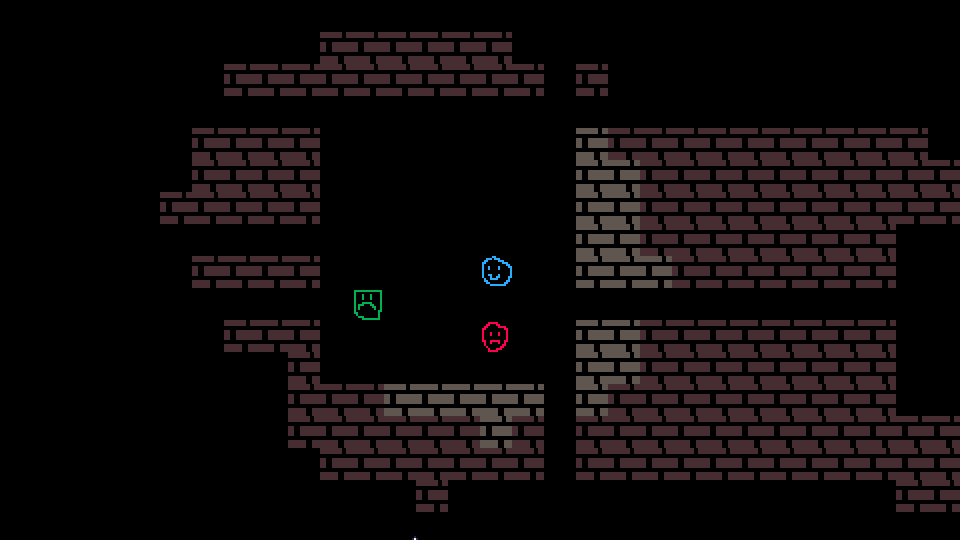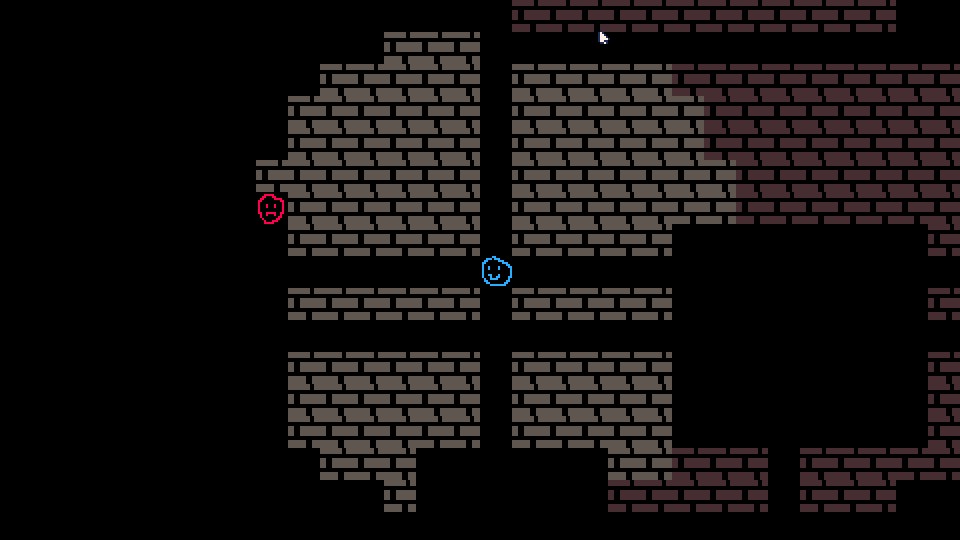Picotron Roguelike Tutorial
A tutorial for making a basic roguelike using Picotron
Project maintained by seawaffle Hosted on GitHub Pages — Theme by mattgraham
Part 6 - Doing Some Damage
In Part 5, we revamped how we make enemies, and laid the framework for attacking. Today we’re going to go all the way and start doing more than just kicking them. Get a snack and a drink, this might take a little while. First off, let’s change our Entity object to add important information.
-- entities.lua
...
-- constructor for generic entity
function Entity:new(args)
local o = setmetatable({}, Entity)
o.x = args.x
o.y = args.y
o.sprite = args.sprite or 0
o.name = args.name or ""
o.blocksMovement = args.blocksMovement or false
o.combatant = args.combatant or false
o.hp = args.hp or 0
o.attack = args.attack or 0
return o
end
-- generic move function for entity
function Entity:move(dx, dy)
local destX = self.x + dx
local destY = self.y + dy
if getBlockingEntity(destX, destY) then
self:melee(destX, destY)
elseif isWalkable(destX, destY) then
self.x = destX
self.y = destY
end
end
-- generic melee attack for entity
function Entity:melee(x, y)
target = getBlockingEntity(x, y)
if target.combatant and target.hp > 0 then
target.hp = target.hp - self.attack
printh(self.name .. " attacks " .. target.name .. " for " .. self.attack .. " damage.")
if target.hp <= 0 then
printh(self.name .. " kills " .. target.name .. "!")
del(entities, target)
end
end
end
...
So here, we’ve added a bunch of new properties to our Entity object:
combatant- This tells us whether this entity should be moving about and fighting.hp- This is your standard hit point pool. When it reaches 0, the entity is dead and removed from the entity pool.attack- This is how much damage the entity will do on an attack. You might notice some different stuff about the constructor. First off, we modified the parameters to just accept a table of arguments. This keeps our function looking a little cleaner. We also added a default value to each argument (theor somethingpart of the line). That lets us specify how a default Entity should look, so we don’t have to always put something for each property.
To deconflict with our new attack property, we’ve renamed the attack() function to melee(). Inside the melee() function, you’ll notice some new logic. If we have a blocking entity, we check to see if it is a combatant and if it has hit points. This way we can implement entities that may be blocking movement, but shouldn’t be attacked, like a tree. If our blocking entity is truly a dastardly enemy, we subtract our attack value from its hp. If the hp is at or below zero, we’ve killed it, and it gets removed from the entity pool. Let’s try it out!

The GIF leaves something to be desired, but trust me, there were some furious button presses and captivating log messages involved in killing that enemy! As you can see, once an enemy is killed, they get removed from the pool and automatically stop being drawn. You can even walk right into the tile they were willing to give their life to defend.
This is all well and good, but killing defenseless monsters leaves something to be desired. We need to get them moving around and trying to take their revenge! Let’s start by taking some pathfinding code from a decent implementation for Pico-8. It’s a little out of scope to worry about pathfinding here, so I’ll just tell you I’m taking code from here because I felt it looked like a pretty good implementation of A* pathfinding, and I’m putting it in pathing.lua, shown below:
-- largely taken from the following implementations:
-- https://github.com/morgan3d/misc/tree/master/p8pathfinder
function find_path
(start,
goal,
estimate,
edge_cost,
neighbors,
node_to_id,
graph)
-- the final step in the
-- current shortest path
local shortest,
-- maps each node to the step
-- on the best known path to
-- that node
best_table = {
last = start,
cost_from_start = 0,
cost_to_goal = estimate(start, goal, graph)
}, {}
best_table[node_to_id(start, graph)] = shortest
-- array of frontier paths each
-- represented by their last
-- step, used as a priority
-- queue. elements past
-- frontier_len are ignored
local frontier, frontier_len, goal_id, max_number = {shortest}, 1, node_to_id(goal, graph), 32767.99
-- while there are frontier paths
while frontier_len > 0 do
-- find and extract the shortest path
local cost, index_of_min = max_number
for i = 1, frontier_len do
local temp = frontier[i].cost_from_start + frontier[i].cost_to_goal
if (temp <= cost) index_of_min,cost = i,temp
end
-- efficiently remove the path
-- with min_index from the
-- frontier path set
shortest = frontier[index_of_min]
frontier[index_of_min], shortest.dead = frontier[frontier_len], true
frontier_len -= 1
-- last node on the currently
-- shortest path
local p = shortest.last
if node_to_id(p, graph) == goal_id then
-- we're done. generate the
-- path to the goal by
-- retracing steps. reuse
-- 'p' as the path
p = {goal}
while shortest.prev do
shortest = best_table[node_to_id(shortest.prev, graph)]
add(p, shortest.last)
end
-- we've found the shortest path
return p
end -- if
-- consider each neighbor n of
-- p which is still in the
-- frontier queue
for n in all(neighbors(p, graph)) do
-- find the current-best
-- known way to n (or
-- create it, if there isn't
-- one)
local id = node_to_id(n, graph)
local old_best, new_cost_from_start =
best_table[id],
shortest.cost_from_start + edge_cost(p, n, graph)
if not old_best then
-- create an expensive
-- dummy path step whose
-- cost_from_start will
-- immediately be
-- overwritten
old_best = {
last = n,
cost_from_start = max_number,
cost_to_goal = estimate(n, goal, graph)
}
-- insert into queue
frontier_len += 1
frontier[frontier_len], best_table[id] = old_best, old_best
end -- if old_best was nil
-- have we discovered a new
-- best way to n?
if not old_best.dead and old_best.cost_from_start > new_cost_from_start then
-- update the step at this
-- node
old_best.cost_from_start, old_best.prev = new_cost_from_start, p
end -- if
end -- for each neighbor
end -- while frontier not empty
-- unreachable, so implicitly
-- return nil
end
function map_neighbors(node, graph)
local neighbors = {}
if isWalkable(node.x, node.y - 1) then
add(neighbors, {x=node.x, y=node.y - 1})
end
if isWalkable(node.x, node.y + 1) then
add(neighbors, {x=node.x, y=node.y + 1})
end
if isWalkable(node.x - 1, node.y) then
add(neighbors, {x=node.x - 1, y=node.y})
end
if isWalkable(node.x + 1, node.y) then
add(neighbors, {x=node.x + 1, y=node.y})
end
return neighbors
end
-- estimates the cost from a to
-- b by assuming that the graph
-- is a regular grid and all
-- steps cost 1.
function manhattan_distance(a, b)
return abs(a.x - b.x) + abs(a.y - b.y)
end
That’s a lot of code. I’m certainly grateful to the people that make things available to learn from online. We’ll add some enemy AI now. Not ChatGPT or anything, just basic ‘if i see the player, I’m going to try to kill them’ game AI. Head on over to entities.lua.
-- entities.lua
...
-- ai function to make entities chase the player
function Entity:ai()
if player and self != player and self.combatant then
-- give enemies a fov of 7 tiles
local start = {x=self.x, y=self.y}
local goal = {x=player.x, y=player.y}
if insideCircle(start, goal, 7) then
path = find_path(start, goal,
manhattan_distance,
function () return 1 end,
map_neighbors,
function (node) return node.y * 8 + node.x end,
nil)
if path then
local p = path[count(path) - 1]
-- do a check to see if a blocking entity that isn't the player
-- is there, we don't want our enemies killing each other
local e = getBlockingEntity(p.x, p.y)
if e and e != player then
return
end
local dX = p.x - self.x
local dY = p.y - self.y
self:move(dX, dY)
end
end
end
end
...
So, in this AI function, we check to see if the player is in existence. Then we check to see if the entity whose brain this is isn’t the player (aka an enemy) and it’s a combatant. If all that is true, we then check to see if the player is visible to the enemy (just using a circle of 7 tiles for now). We don’t want all the enemies in the dungeon swarming us the moment we start. If the player is visible to the enemy, we call off to our pathfinding function to see if there’s a way to get to the player. If so, we move to the next closest step in that path, assuming there’s no other enemy in that spot. By using the Entity:move() function, the melee attack we use gets baked into the enemy movement too, meaning they can totally kill you now. But to get all this to work, we need to give these enemies a chance to use their brains.
-- main.lua
...
include "pathing.lua"
State = {PLAYER_TURN = "1", ENEMY_TURN = "2"}
...
function _init()
currentState = State.PLAYER_TURN
populateMap()
end
function _update()
if currentState == State.PLAYER_TURN then
if btnp(0) then
player:move(-1, 0)
elseif btnp(1) then
player:move(1, 0)
elseif btnp(2) then
player:move(0, -1)
elseif btnp(3) then
player:move(0, 1)
end
updateFOV()
updateMap()
elseif currentState == State.ENEMY_TURN then
updateEntities()
currentState = State.PLAYER_TURN
end
end
...
function updateEntities()
for entity in all(entities) do
entity:ai()
end
end
-- entities.lua
...
-- generic move function for entity
function Entity:move(dx, dy)
local destX = self.x + dx
local destY = self.y + dy
if getBlockingEntity(destX, destY) then
self:melee(destX, destY)
elseif isWalkable(destX, destY) then
printh(self.name .. " moves x: " .. destX .. ", y: " .. destY)
self.x = destX
self.y = destY
end
if player then
currentState = State.ENEMY_TURN
end
end
...
We’ve added pathing.lua to our imports (important to pull that code into our program), and we’ve added game states. Right now we only have two, the player turn and the enemy turn. We’re not doing any complicated logic with speed or anything, everyone gets one turn at a time. In _update(), we check to see whose turn it is. If the player’s, it waits for input, and on a move, switches to the enemy turn afterwards. If it’s the enemy turn, it iterates through all entities, running the Entity:ai() function. After everyone’s had a go, it’s back to the player. Let’s give it a shot!

Wow, everything’s so lively now! If you wander around fighting enemies long enough, you’ll probably even die, which will definitely crash your game. You might notice I bumped up our view radius. That’s so we can see enemies just a little bit before they can see us, feel free to tweak to your liking.
Well, what a fulfilling day, and what a good place to take a break. As always, you can give it a try here. I’ll see you in Part 7!